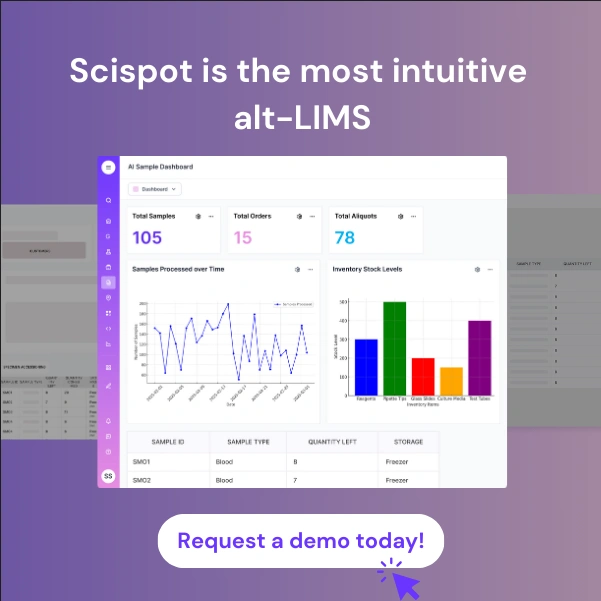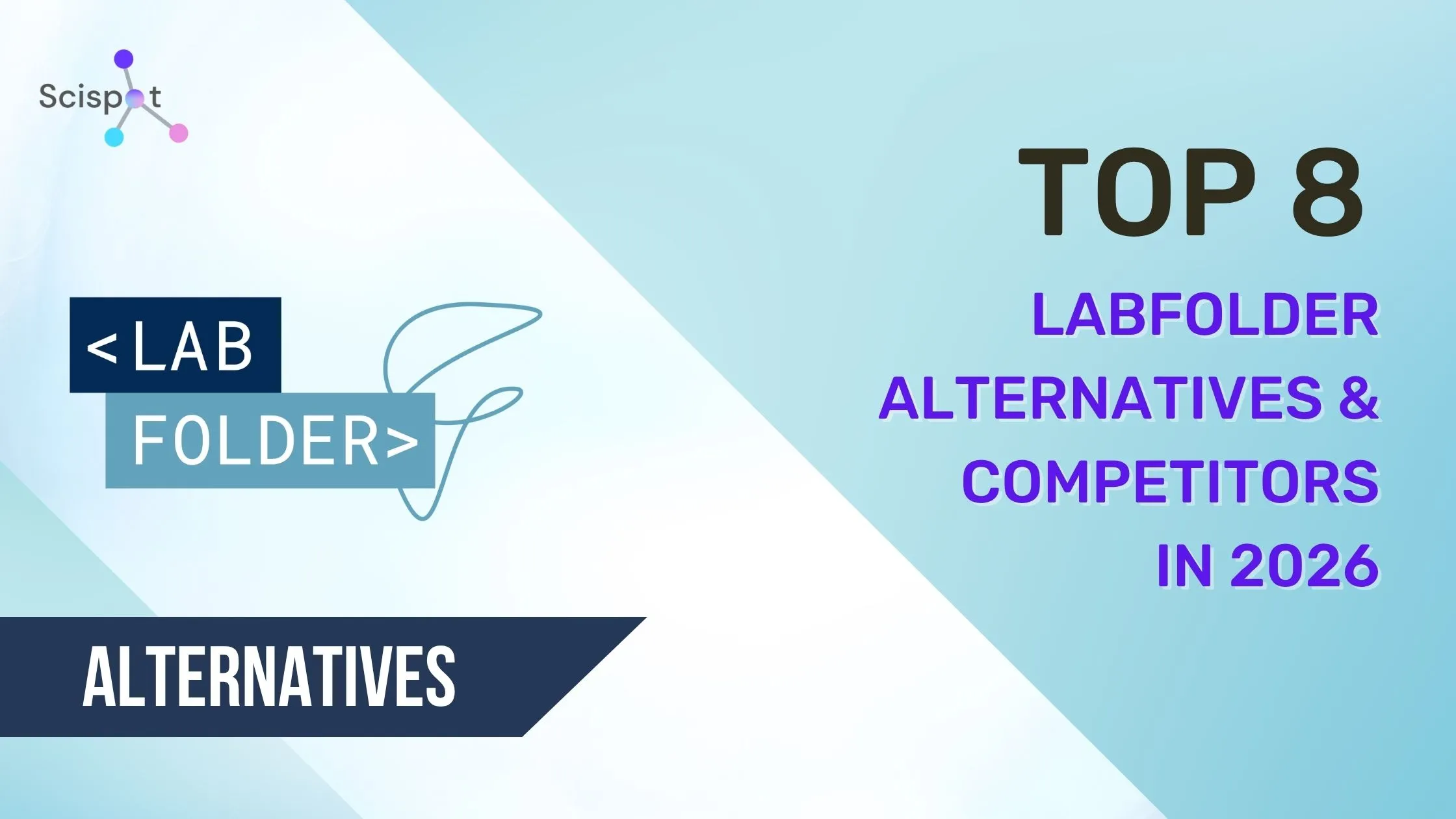Laboratory notebooks have come a long way from the days of pen and paper. Remember that moment when you realized your digital lab tools weren't keeping pace with your research ambitions? That's the turning point many scientists face when evaluating their current electronic lab notebook solution.
While Labfolder has established itself in the research community, the rapidly evolving landscape of scientific discovery demands more than just basic documentation capabilities. Modern labs generating terabytes of data across multiple instruments need platforms that truly connect their digital ecosystem-not just document what happened.
This comprehensive comparison explores eight leading Labfolder alternatives that are reshaping how labs manage workflows in 2026. We'll examine their capabilities, limitations, and ideal use cases to help you identify which solution can transform your lab from documentation-focused to truly data-driven. Whether you're hitting the constraints of basic ELN functionality or planning for future scalability, this guide will navigate the complex decision-making process ahead.
Labfolder Pricing
Labfolder pricing starts with a free plan for small teams (up to 3 scientists) that includes 3GB of storage. For more advanced features, premium plans begin at $18 per user monthly. The pricing structure is divided into Industry and Academia categories, with both offering Basic and Advanced options.
The Industry Advanced and Academia Advanced plans provide additional benefits like unlimited sub-groups, advanced share settings, well plate templates, and 300GB storage per user in the cloud. These plans also ensure compliance with regulations such as ISO 9001 and FDA CFR 21 part 11.

Limitations of Labfolder
Based on Labfolder reviews from actual users, common limitations include:
- Limited storage (only 3GB) in the free version
- Minimal automation capabilities for high-throughput labs
- Limited search functionality, slowing down researchers handling large volumes of data
- Lack of deep integrations with lab instruments
- Basic interface that some users describe as "boring but functional"
Why Consider Labfolder Alternatives in 2026?
The laboratory informatics landscape has evolved significantly, with new technologies enabling more seamless integration, automation, and data analysis. Modern labs require solutions that can:
- Connect with diverse instruments and software platforms
- Scale efficiently as operations grow
- Reduce manual data entry through automation
- Provide actionable insights through advanced analytics
- Adapt to specialized workflows without extensive customization
As research methodologies become more sophisticated and data-intensive, the limitations of basic ELN systems like Labfolder become more apparent. This has prompted many labs to explore Labfolder competitors that offer more comprehensive functionality.
Top 8 Labfolder Alternatives & Competitors in 2026
1. Scispot
.png)
Scispot stands out as the premier laboratory operating system that seamlessly integrates Electronic Lab Notebook (ELN, Lab Information Management System(LIMS), and data warehouse capabilities into a unified platform. Unlike Labfolder's primarily documentation-focused approach, Scispot delivers a comprehensive ecosystem for managing the entire laboratory workflow from experiment planning to execution and analysis.
What truly differentiates Scispot is its innovative API-first architecture, enabling connection with over 7,000 lab instruments and applications – dramatically more than what traditional ELNs offer. This extensive connectivity eliminates data silos and manual entry errors that plague conventional systems. The platform's robust Sample Manager handles the complete sample lifecycle with sophisticated automated tracking, allowing scientists to trace samples through every stage of processing with unprecedented ease.
According to user testimonials, laboratories implementing Scispot's system report reducing sample search time by up to 90% – a significant efficiency gain for time-constrained research teams. Its visual Location Manager provides intuitive storage maps of freezers and racks in real-time, making sample organization straightforward while leveraging advanced barcode integration for rapid scanning.
Scispot's modern, intuitive interface minimizes training requirements and accelerates user adoption, addressing one of the most common challenges in laboratory informatics implementation. Most implementations are typically completed in just 6-12 weeks, compared to the months or years often required for legacy systems – allowing labs to realize benefits almost immediately.
Perhaps most importantly, Scispot's innovative no-code configuration approach empowers laboratory staff to adapt workflows themselves without vendor dependency, dramatically reducing implementation time and ongoing maintenance expenses. The platform also features Scibot, an AI-powered lab assistant that handles manual work while providing intelligent workflow recommendations and data analytics.
For laboratories handling complex multi-omics data, Scispot's code-first automation capabilities through JupyterHub, Python SDK, and CLI allow seamless building, scaling, and deployment of computational pipelines without extensive programming expertise. This combination of user-friendly interfaces and powerful computational tools makes Scispot uniquely positioned to support both wet-lab scientists and computational biologists within the same environment.
2. SciNote
SciNote is used in some FDA, USDA, and European commission labs, offering basic lab inventory and compliance tools. While it provides functional ELN capabilities, it lacks the integrated approach and extensive connectivity found in more comprehensive platforms.
The platform has gained recognition for its scientific customer support, serving users across various countries. SciNote aims to support government, industry, and academic research labs but is still working toward full FedRAMP Authorization for enhanced security credentials.
Despite its reasonable functionality, SciNote's limited integration capabilities and basic automation features may be restrictive for laboratories with more complex workflows or larger data volumes.
3. Benchling
Benchling offers tools for molecular biology, data tracking, and collaboration, making it somewhat popular among certain enterprises in the life sciences sector. However, its high price tag – reportedly ranging from $5,000 to $7,000 per user annually according to user reviews – puts it out of reach for many organizations.
While useful for specific molecular biology applications, Benchling's specialized focus limits its applicability for laboratories working across multiple disciplines. Implementation typically requires substantial technical resources, and the platform's complexity can create a steep learning curve for new users.

4. LabArchives
LabArchives has some adoption in academic settings, offering basic cloud-based storage and organization for research data. However, users frequently report frustration with its outdated interface and limited customization capabilities.
The platform's restricted third-party integration options significantly limit automation opportunities and make synchronization with laboratory instruments challenging. While functional for very small research teams with minimal requirements, LabArchives' limitations become increasingly problematic as laboratory operations scale.
5. Labguru
Labguru provides basic functionality for recording and managing laboratory data through its web-based platform. While it offers some tools for monitoring research progress, user reviews suggest it lacks the intuitive design and advanced integration capabilities found in newer platforms.
Implementation can be lengthy, and customization typically requires vendor involvement, creating potential bottlenecks for laboratories needing to adapt quickly to changing research priorities. For organizations seeking primarily documentation capabilities, Labguru may be adequate, but those requiring comprehensive workflow automation will likely find it insufficient.
6. eLabJournal
eLabJournal provides basic ELN functionality along with simple sample tracking and protocol management. Its cloud-based system allows data storage and some collaboration, with an interface designed primarily for transitioning from paper-based documentation.
As laboratory operations grow, eLabJournal's limitations become more apparent. It lacks sophisticated automation and real-time instrument integration capabilities, making it challenging for high-throughput labs to manage large datasets effectively. Users report minimal workflow customization options, often forcing laboratories to adapt their processes to fit the software rather than the other way around.

7. LabCollector
LabCollector combines basic LIMS and ELN functionality, offering modules for sample tracking and equipment management. It provides some flexibility through different deployment options, but user feedback indicates a steep learning curve and configuration challenges.
The platform is often described as functional but dated, potentially impacting adoption rates and efficiency. While offering reasonable functionality for specific use cases, LabCollector lacks the seamless integration capabilities and modern user experience provided by newer platforms designed for today's interconnected laboratory environments.
8. STARLIMS
STARLIMS is an established LIMS provider that has added ELN functionality over time. It includes compliance features that may appeal to certain regulated industries but comes with significant complexity.
The platform requires specialized expertise to implement and maintain, increasing total cost of ownership beyond the initial Labfolder price comparison. Implementation timelines are typically extended, often measured in years rather than months, creating substantial delays in realizing value from the investment.
What Sets Scispot Apart from Labfolder and Other Alternatives
When evaluating Labfolder alternatives, several key factors differentiate Scispot from both Labfolder and other competitors:
Integration Capabilities
While Labfolder offers basic file importing and minimal app integrations, Scispot's API-first architecture enables connections with over 7,000 lab instruments and applications. This extensive integration framework eliminates data silos and enables unified analytics that provide valuable insights across the laboratory ecosystem.
Implementation Speed
Labfolder and traditional systems typically require months of setup and configuration. Scispot deployments are completed in just 6-12 weeks, with pre-built configurable templates accelerating time-to-value. This allows labs to realize benefits almost immediately rather than waiting through extended implementation periods.
User Experience
Labfolder reviews often mention its functional but uninspiring interface. Scispot's modern design reduces training requirements and accelerates user adoption, addressing one of the most common reasons laboratory software implementations fail. The intuitive interface makes complex operations accessible without sacrificing functionality.
No-Code Configuration
Unlike Labfolder and other traditional solutions that require vendor involvement for customization, Scispot empowers laboratory staff to configure workflows themselves without vendor dependency. This self-sufficiency eliminates dependency on external resources and allows labs to adapt quickly as processes evolve.
Comprehensive Sample Management
Labfolder focuses primarily on documentation. Scispot provides end-to-end sample lifecycle management with automated tracking, visual storage maps, and barcode integration. Users report reducing sample search time by up to 90% after implementing this system.

How to Choose the Right Labfolder Alternative
When evaluating Labfolder alternatives for your laboratory, consider these essential factors:
Scalability
Choose a solution that can grow with your laboratory. Consider not just your current needs but where your organization will be in 3-5 years. Platforms with modular designs and flexible configuration options, like Scispot, adapt more readily to changing requirements.
Integration Capabilities
Modern laboratories operate with multiple instruments and software platforms. Evaluate how easily the alternative can connect with your existing technology ecosystem. Solutions with API-first architectures and extensive pre-built integrations minimize manual data transfers and reduce errors.
Implementation Timeline
Consider how quickly you can realize value from your investment. Traditional systems often require months or years of implementation work before delivering benefits. Newer platforms with configurable templates and rapid deployment methodologies accelerate time-to-value.
Total Cost of Ownership
Look beyond the initial Labfolder price comparison to consider implementation costs, ongoing maintenance, and required technical resources. Solutions requiring extensive vendor involvement for customization often cost significantly more over time than their initial price suggests.
User Experience
The most powerful system provides no value if researchers won't use it. Evaluate the user interface and overall experience to ensure it will promote adoption rather than resistance. Modern, intuitive designs typically require less training and result in higher engagement.
Conclusion
As laboratory operations continue to evolve in complexity and data requirements, the limitations of basic electronic lab notebook systems become increasingly apparent. The top Labfolder alternatives in 2026 offer more comprehensive functionality, better integration capabilities, and improved user experiences that drive research efficiency and quality.
Among the alternatives reviewed, Scispot stands out for its unified approach that combines ELN, LIMS, and data warehouse capabilities in a single platform. Its API-first architecture, no-code configuration, and rapid implementation provide clear advantages over traditional systems like Labfolder.
When selecting the right solution for your laboratory, consider not just current needs but how the platform will support your growth and evolution. The right choice will establish a foundation for continued innovation and efficiency in your research operations.
Ready to experience how Scispot can transform your laboratory operations? Book a personalized demo today to see firsthand how our unified platform can eliminate data silos, automate manual processes, and accelerate your research outcomes.
.gif)





.webp)
.webp)
.webp)



